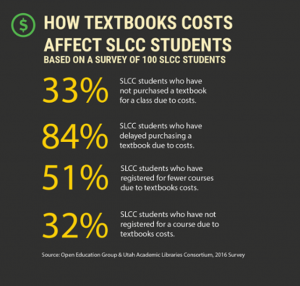4 Why OER?
Benefits of OER
The creation, licensing, sharing, and improvement of open resources provides an abundance of positive outcomes for students, teachers, and institutions.
A Review of the Effectiveness & Perceptions of Open Educational Resources As Compared to Textbooks by Research Shorts, CC BY.
Student Benefits
Enhanced Quality, Greater Flexibility of Resources, and Freedom of Access
With the adoption of OER students are no longer waiting for their financial aid disbursements to purchase textbooks or quite possibly failing to purchase textbooks at all due to cost. As the cost of OER materials is substantially lower than that of traditional textbook the impact on learning is considerable. Students have access to all necessary materials at the start of the course, which can lead to increased student retention, graduation rates and higher course grades .

Lower Cost for Enrollment
When students save money on enrollment costs this can translate into overall increased enrollment. According to a blog post by David Wiley recent research suggests that students who were assigned OER materials in the fall enrolled in over 1.5 credits more in the spring semester than those who were assigned traditional textbooks. For more information regarding this research visit Adopting OER is Better for Everyone Involved .
AIM – Student Perspective by San Francisco State University, All Rights Reserved – Standard YouTube License.
Educator Benefits
Enhanced Academic Freedom
When instructors adopt OER they are no longer required to bend to the will of publishers. The use of OER assures the academic freedom to modify or add content to the faculty member’s (or department’s) specification. Although a faculty member may initially select a readily available open textbook unlike the traditional textbook path this is not necessarily a dead end. Through the 5R’s of open access instructors have the ability to alter every word, image, example, definition and any other aspect of the open textbook to fit the specified needs of the course. Additionally, faculty have an ever-expanding open content base from which they can draw without the rigid barriers associated with traditional textbooks. In the event that the currently available open content fails to meet the needs of instructors they can build their own resources from the ground up.
Shawna Haider Utah OER by Utah OER, All Rights Reserved – Standard YouTube License.
Knowledge Check from UH OER Training by William Meinke, CC BY 4.0.

